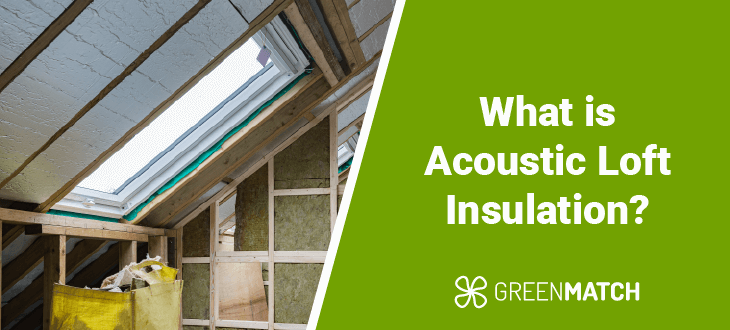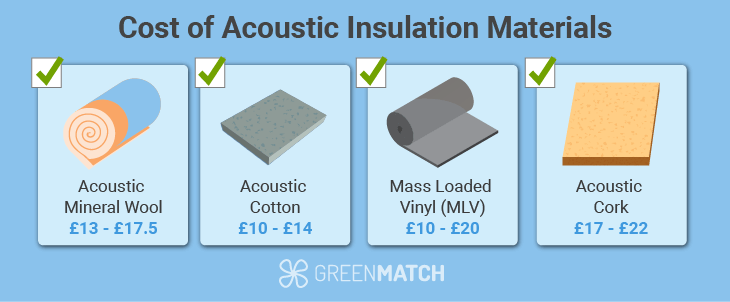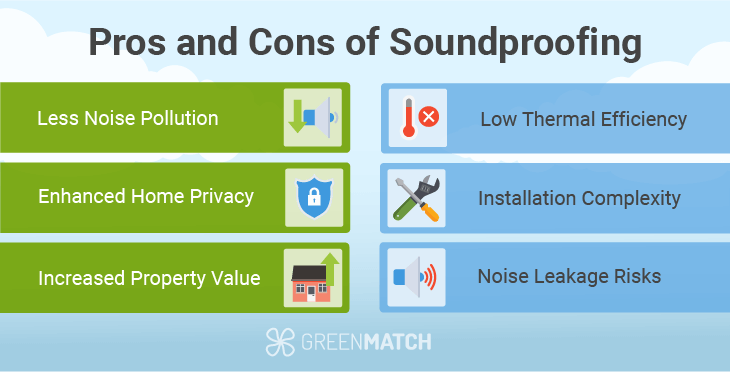Answer these simple questions and we will find you the BEST prices
Which type of solar quotes do you need?
It only takes 30 seconds
100% free with no obligation

Get Free quotes from insulation specialists near you

Save money by comparing quotes and choosing the most competitive offer

The service is 100% free and with no obligation
- GreenMatch
- Insulation
- Loft Insulation
- Acoustic Loft Insulation
Acoustic Loft Insulation in the UK: Costs, Pros & Cons (2025)

- Acoustic insulation consists of high-density materials that absorb or reflect sound waves, creating an environment isolated from the outside sound.
- Acoustic mineral wool costs around £13 - £17.5 per m2, however, there are several other insulation materials on the market to consider, such as MLV and cotton.
- Acoustic loft insulation comes with plenty of benefits, including protection from external noise, enhanced home privacy, and a more peaceful interior.
Acoustic loft insulation is a great way to improve your living space, keeping internal noise in and external noise out. Most effectively, acoustic loft insulation can help homes in urban centres create the indoor peace they can’t get in city life.
But what is the most effective means of acoustic loft insulation? One of the more exposed parts of your home to noise pollution is your loft and roof area. Generally made from less dense materials, the loft area can be a key point where noise exits and enters your home.
This ultimate guide by GreenMatch UK will provide you with everything you need to know about acoustic loft insulation, including how it works, the costs, pros, cons and more.
Ready to sound insulate your home? Look no further than GreenMatch UK for a partner that’s in your corner. Simply fill in our 30-second online form and receive up to 3 free home-tailored quotes from our network of pre-vetted installers. No costs or obligations apply. Click the button below to begin!
- Describe your needs
- Get free quotes
- Choose the best offer
It only takes 30 seconds



How does acoustic loft insulation work?
Acoustic loft insulation works by applying a high-density material to your loft space, which in turn can successfully absorb or even entirely reflect sound waves.
This can be done similarly to thermal insulation, by either insulating your loft floor or even the roof rafters above your loft for a whole-house approach.
Here’s a breakdown of the steps you could expect a professional installer to carry out for roof soundproofing:
- Firstly, the loft space will be cleaned and prepared for the acoustic insulation job. This may require removing outdated insulation, debris, and electrical wiring for safety purposes.
- Then an installer will begin applying the insulation material to your loft. If you are insulating just your home, then your loft floorboards will be lifted, and acoustic insulation material will be laid in the floor joists. If you are insulating your entire loft, then loft insulation between rafters is the most effective approach.
- After the insulation is in place, an installer will make sure it’s secure and potentially cover it up with plasterboard or alternatives for a more aesthetic finish.
All in all, the process of acoustic insulation is not very different from thermal insulation when it comes to loft spaces. Both thermal and acoustic insulation can even be applied on top of each other, however, a professional installer is needed to make sure the job is done right.
Cost of soundproofing a loft

You might be wondering; how much to insulate a loft? The total cost of soundproofing a loft space will hinge on several factors, such as your chosen acoustic insulation material, your loft size, accessibility, existing repairs and much more.
For starters, several key materials are popularly used for acoustic insulation purposes. They’re successful at absorbing and reflecting sound waves due to their high densities. While there is not one best loft insulation material, there are some common finds on the market:
- Acoustic mineral wool: Similar to thermal mineral wool, acoustic wool simply has a much higher density, allowing it to successfully absorb soundwaves and reduce noise transfer. A material density of over 45 kg/m³ and up to 100 kg/m³ works the best as an acoustic insulator.
- Acoustic cotton: Dense cotton is possibly one of the most effective soundwave dampeners, and with an average density of around 55 kg/m³, is considered one of the best options on the market for noise cancellation purposes. While cotton may be a natural material,
- Mass-loaded vinyl (MLV): This innovative sound barrier is one of the leading options on the market due to its durability, thinness, and high acoustic reflectivity. Due to the high density of MLV sheets, the material can effectively reflect sound, creating an impenetrable barrier. One downside is that vinyl is inherently synthetic and unrecyclable, making it a less sustainable option.
- Acoustic cork: As a more natural option, some higher densities of cork boards can provide significant noise cancellation. In addition, cork boards are fully sustainable and recyclable, making for an environmentally conscious choice.
To give you a better idea of what to expect in terms of overall costs, let’s look at a breakdown of these popular acoustic insulation materials' costs per m2:
| Insulation material | Cost per m2 |
|---|---|
| Acoustic mineral wool | £13 - £17.5 |
| Acoustic cotton | £10 - £14 |
| Mass-loaded vinyl (MLV) | £10 - £20 |
| Acoustic cork | £17 - £22 |
Whilst there are grants for loft insulation in the UK aimed at making insulation more accessible to low-income households, these grants primarily focus on the thermal efficiency of a household rather than acoustic efficiency. This is in line with the UK’s ambitious goal to become Net Zero by 2050.
How effective is sound insulation for your roof?
When installed professionally and with consideration to the specifics of your home, sound insulation for your loft and roof can be a highly effective upgrade, reducing noise pollution from outside and enhancing your home privacy all at the same time.
For example, installing high-quality acoustic mineral wool insulation in your loft space can lead to a significant reduction in noise pollution of up to 49dB (Rw), whilst even providing your home with some thermal warmth.
Other materials exclusively manufactured for acoustic insulation, such as MLV, can provide much higher noise reduction levels, creating almost complete noise isolation.
Soundproofing your loft: Pros and cons

Soundproofing your loft, or any part of your home for that matter, comes with a whole host of benefits to your property and your livelihood. Here’s a breakdown of the most important perks you can expect to enjoy with roof soundproofing:
- Less noise pollution: Proper acoustic insulation will help reduce the amount of noise that enters your home from outside. This is especially helpful in dense urban areas, where the unsavoury noise of traffic, commuters, and passersby can be muffled, giving you a more peaceful home to live in.
- Enhanced home privacy: In addition to keeping outside noise at bay, proper acoustic insulation will also help keep inside noise from leaking out, improving the privacy of your home and keeping your business free from prying ears.
- Increased property value: Homes with pre-installed thermal and acoustic insulation are generally valued higher in the housing market. Should you ever plan to rent or sell your house, you’re likely to be valued higher if your home is properly insulated.
Like any upgrade, acoustic insulation comes with its pitfalls that are just as important to acknowledge. Here’s what you should take into consideration when deciding on getting acoustic insulation for your loft:
- Low thermal efficiency: Most acoustic insulation materials are not made to be thermally efficient. Whilst some like mineral wool can provide a balance of both thermal and acoustic insulation, it won’t be as effective as materials such as MLV that are manufactured for the sole purpose of reflecting noise.
- Installation complexity: If you have thermal insulation in place in your loft, then acoustic insulation would need to be laid on top of this. In the future, this can create complexities when one or the other insulation material needs replacing.
- Noise leakage risks: While lower costs of DIY insulation may seem appealing, a poor job can lead to mountain repair costs that exceed your initial investment. Those who choose a DIY installation approach can risk ineffective acoustic insulation and noise leakage, leaving the investment in vain.
With all things considered, acoustic insulation is a home upgrade that will improve your life, if installed correctly and consciously of your home's circumstances.
Should you get acoustic loft insulation?
Insulating your home, both thermally and acoustically, is a great step ahead. Starting with acoustic loft insulation will help drastically reduce noise pollution in your home, and enhance your privacy as well.
Nevertheless, deciding to get acoustic loft insulation is only the first step. The next requires finding the right professional installer at the right price. There are plenty of loft insulation companies on the market to choose from, and most prospective customers find themselves stuck in an endless cycle of researching and vetting installers. Luckily GreenMatch UK can free you from this burden.
Through our nationwide services, we can send you up to 3 free home-tailored quotes directly from our network of trusted installers. No costs or obligations apply. Simply fill out our 30-second form and let the bargains come to you. Click the button below to begin!
- Describe your needs
- Get free quotes
- Choose the best offer
It only takes 30 seconds



FAQ
It is possible to install acoustic insulation in the loft. This can either be done by insulating the loft floor and walls, or by directly insulating the roof rafters above.
Loft spaces can be made more soundproof by adding acoustic insulation to the loft floor and roof rafters. This combination will isolate sound in the loft area from the rest of the home, as well as from the outside, reducing noise pollution and enhancing loft privacy.
The key disadvantage to most acoustic insulation materials is that they do not provide adequate thermal insulation. As such, both types of insulation will be needed to ensure your home is properly insulated.
Adding acoustic loft insulation may seem straightforward, but a poor job can lead to ineffective sound insulation for your roof and a wasted investment. By working with a professional insulation installer, you can make sure you receive a high-quality loft insulation job that provides you with loft soundproofing and privacy comfort for decades to come.

Akif is a copywriter at GreenMatch since 2023. With a keen interest in community sustainability, green solutions and the role of digital media in identifying climate trends, he aims to hone in on his background in International Studies and Digital Media to provide a multidisciplinary approach to written content rooted in credible research and accuracy.
We strive to connect our customers with the right product and supplier. Would you like to be part of GreenMatch?

